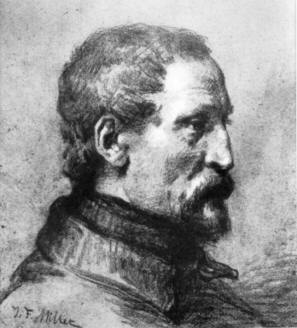S. P. Avery Collection
Miriam and Ira D. Wallach Division of
Art, Prints and Photographs
The New York Public Library
Astor, Lenox and Tilden Foundations

|
The pencil sketch shown here of Karl Bodmer, dated 1850, is signed by the artist, Jean-François Millet. Permission and credit:
S. P. Avery Collection |

|
Johann Carl Bodmer was born in Zürich, Switzerland. When he was thirteen years old, his mother's brother, Johann Jakob Meier, became Carl's teacher. Meier was an artist, having studied under the well-known artists Heinrich Füssli and Gabriel Lory. Young Carl and his older brother, Rudolf, joined their uncle on artistic travels throughout their home country. (Carl changed the spelling to Karl in about 1850.)
A major turning point in Bodmer's life was his being contracted to the Prinz Maximilian zu Wied-Neuweid. Known popularly to naturalists then and even now as Prince Max, this German aristocrat, having successfully led a scientific expedition to Brazil in 1815-1817, decided to embark on another such venture, this time to North America.
By 1828, Bodmer had left his native Switzerland for the German city of Koblenz. It was there that he came to Prince Max's attention. After delays, Bodmer, in the company of Prince Max and a huntsman and taxidermist, David Dreidoppel, set out for America on May 17, 1832. In a letter bearing that date, Prince Max wrote to his brother that Bodmer "is a lively, very good man and companion, seems well educated, and is very pleasant and very suitable for me; I am glad I picked him. He makes no demands, and in diligence he is never lacking."
Arriving in Boston on July 4, the three encountered hardships and delays caused largely by a cholera epidemic in eastern states, sweeping across the north to Michigan. It was not until October 8 that the three began their journey down the Ohio River from Pittsburgh, arriving in Mt. Vernon, Indiana about midnight, October 18. The next morning, the party made their way to New Harmony.
In his famous book chronicling the expedition (cited in the Prinz Maximilian link, below), the Prince wrote, "I had been indisposed, as well as my huntsman, since I left Louisville, and was not in a mood properly to appreciate the fine, lofty forests of Indiana, the road through which was very bad and rough."
Prince Max had planned to spend only a few days in New Harmony, but his stay "was prolonged by serious indisposition, nearly resembling cholera, to a four months' winter residence." The Prince devotes a whole chapter of his book to New Harmony, its environs, and to the work and personalities of two leading American naturalists who lived there, Thomas Say and Charles-Alexandre Lesueur. Lesueur was also a prolific artist.
Unlike the Prince and huntsman, Bodmer was not ill-disposed. Alone, he left New Harmony at the end of December, and on January 3, 1833, caught a steamboat at Mt. Vernon. He traveled to New Orleans and spent a week with Joseph Barrabino, an Italian-American naturalist and friend of Say and Lesueur. A fine pencil portrait of Barrabino, drawn by Lesueur, is preserved at the New Harmony Workingmen's Institute. A reproduction appears on page 647 of
Josephine Mirabella Elliott, editor, Partnership for Posterity: The Correspondence of William Maclure and Marie Duclos Fretageot, 1820-1833, Indiana Historical Society, Indianapolis, 1994.
On page 1033 of the same work, Prince Maximilian, Karl Bodmer, and David Dreidoppel are pictured together, and the next page shows a black-and-white rendering of a watercolor by Bodmer in which the subject is Lesueur.
It was on his southern travels that Bodmer first painted Native Americans, members of the "once mighty and glorious" Choctaw, Cherokee, and Chickasaw tribes. On February 15, he returned to New Harmony, where Prince Max recorded his adventures.
Prince Max and his party left New Harmony on March 16, 1833 and made their way westward to St. Louis, Leavenworth, Fort Pierre on the Teton River, Fort Clarke, arriving at Fort Union, near the mouth of the Yellowstone River, on June 24. From there they traveled to Fort McKenzie (August 9 - September 14) and then began the return trip.
After wintering at Fort Clarke, the expedition arrived once again at Mt. Vernon, Indiana, on June 6, 1834. Recalling the Prince's earlier description of the road to New Harmony, written when he was ill-disposed, it is amusing to read his second description: "This road, which I have already described, was extremely pleasant, on account of the luxuriant foliage of the lofty forest..." On June 9, the three left New Harmony, and on July 16 they sailed for Europe.
During the expedition, Karl Bodmer fufilled his contract to Prince Max. He painted masterpieces of their genre, showing in detail individual Native Americans, as well as species of mammals, reptiles, and amphibians, and wonderful landscapes. Many of these works are reproduced in
Karl Bodmer's America, Introduction by William H. Goetzmann, Annotations by David C. Hunt and Marsha V. Gallagher, Artist's Biography by William J. Orr, Joslyn Art Museum & University of Nebraska Press, 1984.
The biography of Bodmer by Orr has served as the main reference for writing this page. It appears to be by far the most detailed account in print and is highly recommended.
You may view a few of Bodmer's paintings by visiting the website of the Joslyn Art Museum (link below), but, of course, there is no substitute for a visit to the Museum itself, or the traveling exhibition of the expedition.